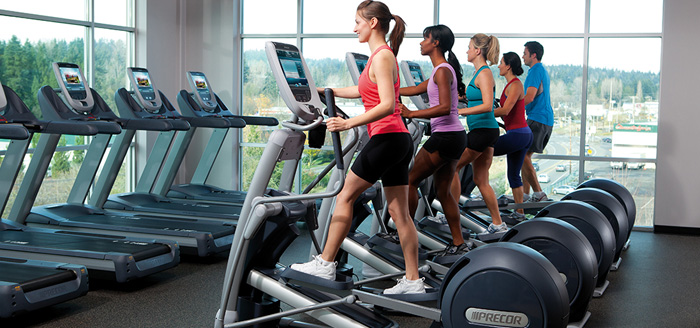Are you burning the calories your cardio machine thinks you are?

At the beginning of my journey, I counted everything. Every calorie I ate, ever calorie I burned. I paid attention to my heart rate, the distance that I covered, the duration of time that I exercised and since the beginning, one of the biggest discrepancies I saw in numbers was in the amount of total calories burned that cardio machines reported.
Today I spent 65 minutes on an elliptical doing a cross country program that varied the resistance from anywhere from level 3 to level 18 during my workout. When I was done, the elliptical reported a total calorie burn of 907 calories. The machine is taking into consideration my age, weight, time, and pace when determining my calorie burn.
The Fitbit Surge on my wrist calculated that same workout at 66 Minutes, 5596 steps, and with an average heart rate of 130BMP during my workout calculated the same workout at 595 calories.
My target heart rate zone as a 38-year-old female is between 93 and 157 beats per minute. So I’m pretty okay with working out at that intensity for 60 minutes. My heart rate is typically in the 140s during harder parts of my workout and drops as low as 125 during the recovery stages after my intervals.
So the same workout according to the cardio machine burned 312 calories more than my fitness tracker. That is an outstanding 41% difference. We’re not talking about 20 calories here, we’re talking about the same amount of calories as the 6 inch turkey and provolone on wheat with some of the bread scooped out that I’m eating for lunch today.
As a weight loss and wellness coach, I am constantly encouraging my clients to keep food and exercise journals. Studies have proven that those that keep food diaries are 50% more successful in weight loss than those that don’t.
I usually recommend my clients keep a separate exercise journal so that they are tracking numbers that are more relevant to their exercise routine. Mainly we want to insure that we are seeing the progression and that the routine is indeed getting your heart rate into your target heart rate zone.
This also helps insure that there is no confusion when using applications such as MyFitnessPal – where the application will add the calories burned in a day as I am often asked by clients if they should eat those extra calories.
Understanding how we create caloric deficits and what sort of deficits you need to produce at the end of the day is an important part of the weight loss journey. Currently in the fitness industry we recommend that the average person trying to achieve weight loss attempt to create caloric deficits of 500-1000 calories a day through proper nutrition, activity, and exercise.
Basic cardio recommendation for someone trying to lose weight is 60 minutes of moderate cardiovascular activity 5 days a week for a grand total of 300 minutes a week.
I teach my clients that something as simple as adding one glass of wine (an average of 123 calories per 5oz serving) per evening without adding exercise and activity that counters it can add up to 3,690 calories a month, a total of 44,280 calories or – 12.6 pounds a year.
If I was tracking calories and activity and depending on a cardio machine to get my caloric burn information and it was off by 300 calories a day on average – that’s an error of 9,000 calories or – 2.5 pounds a month. This could make an awfully big difference in my calculations and expectations if I’m not careful.
This can have a big impact on weight maintenance as well. If I think I am burning 300 extra calories a day than I might eat more thus hindering my weight maintenance by causing unexpected gain.
Everyone is different; each person’s body has a unique base metabolic rate and their metabolism burns differently. Each of us has our own fitness level as well as our own level of cardiovascular endurance. The fitter you become the lower your resting heart rate goes and the harder you have to work to get your heart rate up.
As an example, last Monday in my weight loss boot camp class one of my clients and I wore a fitness tracker that tracked our heart rates and calorie burn during the workout. My calorie burn during the class was close to 250 while hers was nearly 600. Why is she getting so much more out of the workout than I am? Because the workout is a lot harder for her at her fitness level than it is for me at mine and thus, since her body is working harder, she is burning more calories than I am.
So should you trust the calorie burn indicated on your cardio machine as part of your calorie deficit for the day? In my professional opinion, survey says EHH.
Even though the makers of cardio equipment will tell you that they are constantly improving the technology behind the calculations you see on the machines you are likely seeing a 20-40% calculation discrepancy.
While the most accurate way to measure the amount of calories burned during a workout would be to measure oxygen consumption during exercise using a machine that measures ventilation and the carbon dioxide concentration of inhaled and exhaled air to calculate V02 max. These tests can be time-consuming, require appointments and can be costly.
Fitness professionals are trained to be able to estimate V02 Max in a field setting using a 1.5 mile run, 12 minute run or 1 mile walk test.
If you don’t have access to these tests or a personal trainer and calculating your calories burned against your calories in is important to you I’d recommend investing in a reliable heart rate monitor or activity monitor that has a heart rate monitor built into it to get a more accurate number and insure that your time and calorie expenditure journaling effort is as helpful to your overall goals as it can be.
I would also like to say devices like the FitBit of any other trackers aren't the most accurate thing when it comes to measuring activity and the calories burned. At most they are making a guesstimate of what you are doing. Lifting my Water bottle to my mouth counts as a step. Also the wearables with heart rate monitors are less accurate that a good old chest strap monitor. There are many Youtube videos showing the difference. They can be off by as much as 10 to 20 BPM.
All that being said they are still great motivation devices. I just take the numbers from these device with a grain of salt. The same way I don't fully trust the numbers the gym cardio equipment is telling me.


Alex Brecher 10,494
Posted
Pandora,
Thanks for the article and the reminder that machines at the gym are notoriously generous with the calorie burn they claim! You’re absolutely right that these numbers can be very misleading and add up to big mistakes when you’re trying to lose weight by counting every calorie burned.
I don’t know how true it is, but I’ve heard a good rule of thumb for ellipticals is to subtract about one-third of the calories they tell you (so if they say 300 calories, subtract 100 and you’ve probably burned 200). That’s about what you suggested – 20 to 40%. A lot of times, if it sounds too good to be true, it is.
Share this comment
Link to comment
Share on other sites